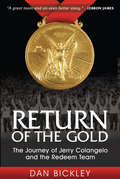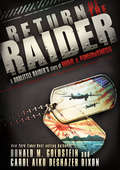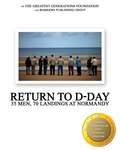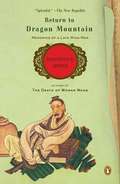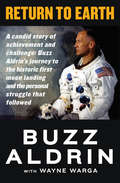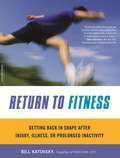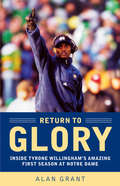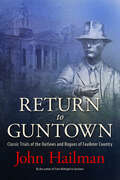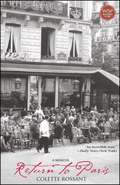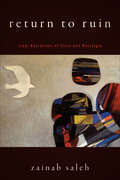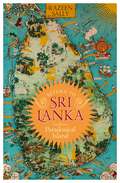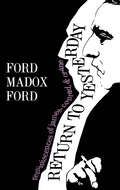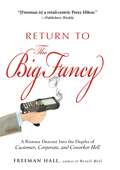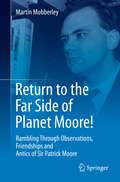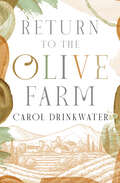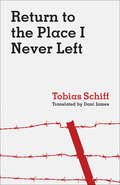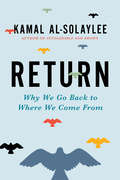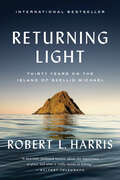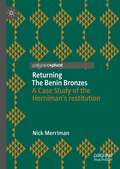- Table View
- List View
Return of Old Maine Woman: Tales of Growing Up and Getting Older
by Glenna Johnson SmithThe Old Maine Woman returns with her customary combination of sass, insight, and nostalgia in a host of new essays that shed their own particular light on the quandaries of being female, growing up, getting married, and getting older as a woman in the northern parts of the state. The twinkling eyes of Glenna Johnson Smith don't miss much, a skill that served her well when she was a 7th and 8th grade teacher, and also allow her to capture the deeper meaning beneath life's seemingly mundane moments. Filled with grace, humor, and fortitude, Return of Old Maine Woman will captivate the reader with its straightforward observations and heartwarming outlook. For anyone who has longed to hear the insight of a relative that has seen something of this life, Return of Old Maine Woman will fill that role, and more. Join Glenna Johnson Smith in this lovely and engaging book, as she recounts what she has taught and what she has learned during the better part a century well-lived.
Return of the Gold: The Journey of Jerry Colangelo and the Redeem Team (Sports Professor)
by Dan BickleySix years after Michael Jordan won his last NBA championship, American basketball hit rock bottom. The perception of NBA players reached an all-time low. Team USA lost three times, disgracing the nation at the 2004 Olympics. With great historical sweep, bringing in the voices of all-time greats like Jordan, Bill Russell, Julius Erving and Jerry West, the book will show how American basketball bottomed out. It will chart the path of Jerry Colangelo, a great sportsman who set out to change the stained image of USA Basketball. And with great insight and fresh detail, it will show how two of the best players in history – Kobe Bryant and LeBron James – spun their own tails of redemption in while winning gold medals.
Return of the Lost Son: Memories of My Wayward Father
by Christopher GonzalesA son searches for his father, only to grow uncomfortable—and even miserable—with what he exhumes. Where, he asks, are the limits of forgiveness? Is failure a badge of honor? Are we free to share the secrets of the dead? In Return of the Lost Son, a vivid, tightly paced memoir, Christopher Gonzales attempts to understand a man who, due to early-onset Alzheimer’s, was unable to share his own memories.At the outset of his exploration, Gonzales hopes to discover a benevolent father figure, someone he could imagine guiding him through the difficult terrain of life. Instead, he is met with shadowy fragments of his father’s habits—drinking, womanizing, and aloofness—as well as a hidden marriage, which all force Gonzales to acknowledge that he might never uncover the angel he hoped to find. Constructed with clear-eyed prose and abounding with colorful travel stories, wending inner journeys, and psychological intricacies, Return of the Lost Son emerges from a committed project of asking and listening, recovering memory and community, and ultimately, healing.
Return of the Raider: A Doolittle Raider's Story of War & Forgiveness
by Mr. Donald M. Goldstein Ms. Carol Aiko DixionJacob DeShazer, a farm boy from Oregon, joined the army Air Corps at age 27. He had always wanted to be a pilot, but when he did not qualify, an opportunity opened to become a bombardier. By luck of the draw, Jacob found himself as one of the 80 men participating in the famous Doolittle Raid over Japan shortly after the bombing of Pearl Harbor.During the raid, Jacob and his fellow crewmen bailed out over China and were taken captive by the Japanese as prisoners of war for more than three years. In that Japanese POW camp, every day facing torture and death, Jacob&’s path changed when his request for a Bible was fulfilled. Jacob came back to the Christian faith in which he was raised, and made a vow to God in his prison cell that if he survived he would return to Japan, not as a warrior but as a missionary.The Jacob DeShazer story is not only about the bravery of a soldier during war, but also about how powerful love and forgiveness can be when given to the enemy.
Return to D-Day: 35 Men, 70 Landings at Normandy
by The Greatest Generations Foundation Warriors Publishing Group<p>A World War II veteran in the twilight of his life stands once again on the soil where he fought the Nazis when he was a young man. He remembers those long-gone days of terror and valor and thinks of friends who died before his eyes. In a voice tinged with age and emotion, he talks about what he saw and heard and felt. Why would he want to revisit the places where he saw hell erupt around him? For many veterans, the experience brings a sense of closure to memories that often have been locked away like an old uniform. They find healing in places where once they witnessed the worst--and the best--that humanity has to offer. <p>Since 2004, The Greatest Generations Foundation has offered the opportunity for veterans to return to their battlefields at no cost to them. These voyages back to the battlefields are often emotional, providing aging veterans a long-overdue method of dealing with their war experiences, a chance to re-kindle pride in their service and sacrifices, and a venue to educate others. <p>In<i> Return to D-Day</i>, you can share in the stories of 35 such men, accompanied by John Riedy's striking photographs that capture the raw emotions of their return to a pivotal battlefield of World War II in Europe. These are tough men who did things in war that often seem impossible today, things that needed doing if the world was to shake free of Nazi tyranny. Standing on Normandy Beaches, once among the bloodiest battlegrounds of military history, they humbly reflect on those events with acute and incisive hindsight. These men changed the course of history.</p>
Return to Dragon Mountain
by Jonathan D. Spence"I have read Jonathan Spence's many previous books . . . but Return to Dragon Mountain is his masterpiece to date . . . Zhang Dai, an important historian of the Late Ming Dynasty, China's Golden Age, is so rendered by Return to Dragon Mountain that I am reminded of the narrator in Marcel Proust and also of Joseph Conrad's. . . darkly fated heroes. " Harold Bloom
Return to Earth
by Buzz Aldrin Wayne WargaBuzz Aldrin's courageous, inspiring account of fame and depression following Apollo 11 When Buzz Aldrin returned victorious from the Apollo 11 mission as one of the first men to have walked on the moon, he didn't realize that, in other ways, his odyssey had just begun. "There was a jolt as the small drogue chutes opened," Aldrin relates in the opening passages of Return to Earth, remembering his abrupt descent into the gravity of the blue planet. "We landed with all the grace of a freight elevator." And with that atmospheric splash, Aldrin and coauthor Wayne Warga take us on a journey through the human side of the space program as the astronaut learns to cope with the sudden pressures of being a lionized public persona. In honest, stripped-away prose, Aldrin reveals a side of instant fame for which neither West Point nor NASA could have ever prepared him. One minute a fighter pilot and engineer, the next a cultural icon burdened with the adoration of thousands, Aldrin gives a candid account of the depression that resulted from trying to be too many things to too many people, leading the astronaut to later remark, "I traveled to the moon, but the most significant voyage of my life began when I returned from where no man had been before." Speaking openly about the affair that threatened his marriage and the concerns that plagued him upon returning from the historic mission, Aldrin pens a compelling memoir that also serves as an excellent guide for those times in life when power and success conspire to corrupt even the best of us.
Return to Fitness
by Bill KatovskyFrom the coauthor of "Bike for Life" and founder of "Tri-Athlete Magazine," comes an indispensable guide to regaining health and fitness after illness, inactivity, or injury
Return to Glory: Inside Tyrone Willingham's Amazing First Season at Notre Dame
by Alan GrantWith a new afterword, the insider's story of Notre Dame's first black football coach and his amazing debut with the Fighting Irish
Return to Guntown: Classic Trials of the Outlaws and Rogues of Faulkner Country
by John HailmanA federal prosecutor in Mississippi for over thirty years, John Hailman routinely worked with federal agents, lawyers, judges, and criminals of every type imaginable. Encouraged by the acclaim for his earlier book, From Midnight to Guntown, he has opened even more of the astonishing cases within the over thirty-five boxes full of trial stories he carried into retirement. Hailman gathers colorful exploits of eccentric modern criminals from William Faulkner's Mississippi, where savvy victims often outwit their criminal perpetrators. Characters range from rich but incompetent drug lords and nationwide gun-runners to bumbling Dixie Mafia kidnappers. The book ends with “Fancy Frauds” in which ingenious con men (and women) offer hilarious but surprisingly sophisticated “special deals” on tax-free gold mines in Mexico and bargain (but bogus) Viagra. Chapters include “Guns, Bombs, and Moonshine Whiskey,” “Drug Kingpins Have Troubles Too,” “Crime Victims Fight Back,” “Mere Theft,” and “Fancy Frauds.” Written to entertain and enlighten, these stories will delight any fan of the true crime genre and anyone who enjoys good writing and the skill of a master storyteller.
Return to Paris: A Memoir
by Colette Rossant"My first meal in France, in a hushed and formerly elegant dining car, was a revelation. The menu was absurdly simple; there was a choice of an omelette aux fines herbes or a sandwich jambon beurre. I chose the omelette and was delighted by the flavors of chives, tarragon and chervil mingling in the creamy lightness of the eggs, all so new to me. If the food in France was so good even in a train, I thought I might have a happy life here after all." In 1947, as Paris recovers from the war, young Colette returns to the city of her birth after eight years spent among warmhearted Egyptian relatives in Cairo. Initially Paris seems gray and forbidding to the young Colette, especially after her mother abandons her to the disinterested care of her stern grandmother. Yet Paris will prove the place where Colette awakens to her senses. Her transformation from "l'Egyptienne" to "la Parisienne" begins when she is taken under the wing of the family cook, Georgette, who introduces Colette to the city's markets and inspires a love and talent for French cooking. The streets of Paris soon become Colette's own as she navigates to and from her lycée -- occasionally skipping class altogether, thus beginning a decades-long habit of making room for adventure in an otherwise disciplined life. Colette is sixteen when her mother returns with a new husband, and although initially suspicious of the round man with the twinkling eyes, she soon realizes she has a soul mate in Almire Ducreux, her new stepfather. Mira introduces Colette to her first truffle and her gastronomical self. He will also be the only one to support her when she falls in love and runs away with a young American, scandalizing her proper French family. With Return to Paris, Colette Rossant proves herself the true heir of M. F. K. Fisher. In clear, understated prose she writes of a life lived and enjoyed passionately. Memories and family stories segue gracefully into descriptions of great meals and recipes. This is food writing at its finest.
Return to Ruin: Iraqi Narratives of Exile and Nostalgia
by Zainab SalehWith the U.S. invasion of Iraq, Iraqis abroad, hoping to return one day to a better Iraq, became uncertain exiles. Return to Ruin tells the human story of this exile in the context of decades of U.S. imperial interests in Iraq—from the U.S. backing of the 1963 Ba'th coup and support of Saddam Hussein's regime in the 1980s, to the 1991 Gulf War and 2003 invasion and occupation. Zainab Saleh shares the experiences of Iraqis she met over fourteen years of fieldwork in Iraqi London—offering stories from an aging communist nostalgic for the streets she marched since childhood, a devout Shi'i dreaming of holy cities and family graves, and newly uprooted immigrants with fresh memories of loss, as well as her own. Focusing on debates among Iraqi exiles about what it means to be an Iraqi after years of displacement, Saleh weaves a narrative that draws attention to a once-dominant, vibrant Iraqi cultural landscape and social and political shifts among the diaspora after decades of authoritarianism, war, and occupation in Iraq. Through it all, this book illuminates how Iraqis continue to fashion a sense of belonging and imagine a future, built on the shards of these shattered memories.
Return to Sri Lanka
by Razeen SallyA blend of travel writing, memoir, history and current affairs that tells the story of Sri Lanka. A perfect read for first-time visitors, Sri Lankans abroad or at home, or anyone looking to deepen their understanding of one of the world&’s most fascinating and paradoxical countries. Razeen Sally was born to a Sri Lankan Muslim father and a Welsh mother. Just before his teens, a political conflict tore his family apart and he left Sri Lanka, barely going back for thirty years. When he finally returned &‘home&’, he spent much of the next decade crisscrossing the island, trying to understand this paradoxical place. Blessed with nature&’s bounty and an easy, pleasure-loving people, it was nevertheless scarred by ethnic conflict and the violence of civil war. As a native and a tourist, Sally makes an ideal guide to Sri Lanka&’s past and present. He won&’t tell you which restaurant has the best reviews or the price of a hotel room. Instead, he will accompany you like a learned friend, sharing his journeys, pointing out the unmissable gems beyond the obvious spots, and unpacking the nation&’s culture and history. Insightful, intimate and moving, Return to Sri Lanka is an indispensable book, whether you're already familiar with this spectacular country, or planning your first visit.
Return to Yesterday: Reminiscences Of James, Conrad, And Crane
by Ford Madox FordFord wrote with engaging frankness about himself and his contemporaries. These reminiscences are an intimate personal record of a life distinguished by literary achievements and friendships with notable writers of his time. Ford's accounts of his literary collaboration with Joseph Conrad, of Stephen Crane's last years in England, and of Henry James at home in Rye are fascinating. A most valuable, long out of print book by the author of The Good Soldier, No More Parades, A Man Could Stand Up, and Last Post.
Return to the Big Fancy: A Riotous Descent Into the Depths of Customer, Corporate, and Coworker Hell
by Freeman HallBigger, Fancier, and more cutthorat than ever!When Freeman Hall left The Big Fancy to pursue his screenwriting dreams, he thought the horrors of working in a handbag department were finally over. But instead of fame and fortune, he found himself stuck behind a wall of script-killing rewrites, unable to make a living.In Return to the Big Fancy, Freeman shares his wildly entertaining journey back through the fiery gates of Retail Hell. He thought he had seen it all in his day, but with the bar set higher than ever before, employees are now graciously bowing before Corporate as they climb over fellow salespeople, and even friends, to earn enough transactions and commissions to actually survive. As he learns more of the wretchedness that has befallen the sales floor, he realizes that The Big Fancy has its customers and its employees on a short leash. But leave it to Freeman and the threat of disappearing commissions to rally the retail slaves and show Corporate who's really in charge!
Return to the Far Side of Planet Moore!
by Martin MobberleyThe result of an exhaustive study of Sir Patrick Moore's observations of the Moon and planets for more than 60 years, this book is a fantastic companion to the extremely popular, "It Came From Outer Space Wearing an RAF Blazer!" written by the same author. Moore recorded his telescopic observations in his logbooks, which are reproduced and described here in detail, along with his sketches and notes. In this light, the author discusses the factors that caused Moore to switch from lunar observing to planetary and variable star observing. He has also included personal recollections and humorous anecdotes from Moore's friends and acquaintances, as well as a look at his best loved books. Further chapters describe Moore's foreign travels and correspondence with those back home. Lastly, the author has not neglected a few of Moore's most memorable television and radio appearances, which are examined along with a close up of what it was like to visit Moore's beloved home of Farthings in Selsey. Essentially, this is a book written by popular demand from the readers of the author's original biography, who craved more of Moore!
Return to the Olive Farm (The Olive Farm Series)
by Carol DrinkwaterAt a small farm in Provence, a woman tries to do her part to save the bees—and the planet—in this stirring, entertaining memoir. After a long research trip, Carol Drinkwater is back home with her husband, Michel, on their olive farm in the south of France. She&’s overjoyed, but also has something serious on her mind: the ecological threats to their own farm—and countless others. The die-off of honey bees has reached crisis levels globally, and Carol is concerned about the state of their hives. Some farmers and scientists believe urgent change is needed to address agricultural techniques that are destroying the planet. But when Carol joins their chorus, it may put their beloved farm in jeopardy. It&’s time for a true commitment—but running an organic farm, the couple soon discovers, is not as simple as it sounds . . .Praise for the Olive Farm series &“Vibrant, intoxicating and heartwarming.&” —Sunday Express &“Spellbinding . . . a must for anyone who dreams of moving to a kinder climate and starting a new life.&” —Choice
Return to the Place I Never Left
by Tobias SchiffA personal testament in poetry to survival, resilience, and the complex legacy of the Holocaust. In this harrowing firsthand account of the Holocaust, survivor Tobias Schiff displays the depths of human suffering, the capacity for hope and renewal, and the impact of starvation on the human mind. Schiff was a teenager when Nazis deported his family to Auschwitz from Antwerp, Belgium, and he spent the next thirty-three agonizing months in numerous concentration camps. This deeply personal memoir-in-verse explores personal faith, identity, memory, and trauma across a lifetime interrupted by suffering. Through his eyes, readers witness the atrocities and struggles that defined his daily existence, feel his tenacity while beaten and starved, and learn what enabled him and others to cling to life while surrounded by death. Schiff's verse challenges dehumanizing narratives and provides an intimate view of the realities of life in Nazi death camps and the long-lasting impact of trauma. As racism, antisemitism, and Islamophobia resurge and continue to pollute the modern era, his pain—imparted through concise, rhythmic verse—serves as a reminder of our collective humanity and a tribute to the resilience of the human spirit.
Return to the Reich: A Holocaust Refugee's Secret Mission to Defeat the Nazis
by Eric LichtblauThe remarkable story of a German-born Jew who escaped Nazi Germany only to return as an American commando on a secret mission behind enemy lines.Growing up in Germany, Freddy Mayer witnessed the Nazis’ rise to power. When he was sixteen, his family made the decision to flee to the United States—they were among the last German Jews to escape, in 1938. In America, Freddy tried enlisting the day after Pearl Harbor, only to be rejected as an “enemy alien” because he was German. He was soon recruited to the OSS, the country’s first spy outfit before the CIA. Freddy, joined by Dutch Jewish refugee Hans Wynberg and Nazi defector Franz Weber, parachuted into Austria as the leader of Operation Greenup, meant to deter Hitler’s last stand. He posed as a Nazi officer and a French POW for months, dispatching reports to the OSS via Hans, holed up with a radio in a nearby attic. The reports contained a goldmine of information, provided key intelligence about the Battle of the Bulge, and allowed the Allies to bomb twenty Nazi trains. On the verge of the Allied victory, Freddy was captured by the Gestapo and tortured and waterboarded for days. Remarkably, he persuaded the Nazi commander for the region to surrender, completing one of the most successful OSS missions of the war.Based on years of research and interviews with Mayer himself, whom the author was able to meet only months before his death at the age of ninety-four, Return to the Reich is an eye-opening, unforgettable narrative of World War II heroism.
Return to the River: Reflections on Life Choices During a Pandemic
by Dave PelzerFrom #1 international bestselling author, speaker, and humanitarian Dave Pelzer comes the next chapter in his life—how, after spending decades saving others in the military, as a fire captain, and an internationally acclaimed advocate, he needs to confront a way to save himself. On the surface, Dave Pelzer&’s life seems like an action movie—he&’s walked the red carpet with celebrities and stood shoulder to shoulder with soldiers in Iraq; he&’s flown top-secret missions for the U.S. Air Force, obtaining the rank of chief, and battled wildfires in California as a volunteer fire captain. And now—on the eve of the 50-year anniversary of this rescue from horrific childhood of abuse and into the safety of the foster care system—he reflects on the battles he&’s fighting in his own heart. From a lifetime spent serving and saving others, can he learn how to serve and save himself? Banished to his basement at age five, Dave Pelzer had cried a river of tears before most children learned to tie their shoes. His now classic books, A Child Called &“It&” and The Lost Boy, chronicled how he was brutally beaten and starved by his emotionally unstable, alcoholic mother: a mother who nearly killed him multiple times. But despite the odds stacked against him, he rose to become a #1 New York Times bestselling author, inspirational speaker, and internationally recognized humanitarian. After fighting for years to vanquish his pain and to channel it into service for others, Pelzer sifts through the psychological rubble of a life that has seemingly crumbled around him. What he shares is deeply transformative and unflinchingly honest. In his struggle to simply survive, he never learned how to just be. Reeling from the loss of a love—and a broken spirit—Pelzer must reconcile his life choices and free himself of blame and shame to find peace and renewed purpose. Amidst the towering redwood trees and the serenity of his childhood utopia of the Russian River, Pelzer reflects on having the courage to move forward in your life, the peace to accept yourself, the vulnerability to strip yourself of facades, and to find the tenacity to carry on when life doesn&’t turn out the way you planned. For anyone who has been hurt, victimized, or feels alone, there is hope and there is always a way to rewrite your own story. Pelzer&’s soulful and inspiring story will remind you to keep your faith, live with gratitude, and find the well of resilience deep within you.
Return: A Journey Back to Living Wild
by Lynx VildenIn this stunning memoir, beloved internationally acclaimed earth advocate chronicles her journey to reconnect with the earth, offering a model for how we all can nurture the wild around and inside ourselves.In 1991, twenty-four-year-old Lynx Vilden crawled out of a sweat lodge covered in mud, her face streaked with tears, and whispered a promise to the earth: “I will love you and cherish you, I will learn how to live and share what you teach me.” That promise became Vilden’s life purpose: to return to the ways of our oldest ancestors, to a simpler life, and to listen deeply to Earth and what she has to say. Over the next thirty years, Vilden’s mission would lead her far from the city streets and punk bands of London and Amsterdam where she was raised, on a long and winding journey spanning continents and seasons, and filled with indigenous wisdom, Stone Age hunting skills, and important lessons from nature.In this illuminating memoir, Vilden shares the joys that await all of us when we reconnect with the earth, when we recognize what has been lost, and understand what we gain by meaningfully returning to our roots and become rewilded. Return is a glimpse into her extraordinary world—from stories about mentoring Silicon Valley millennials at her Stone Age immersion in rural Washington State to adventures traveling among Sami reindeer herders in Arctic Sweden to detailing the intricacies of just how to pursue and survive a wild lifestyle inspired by Stone Age humans.This extraordinary debut ultimately invigorates our hunger to renew our bonds with the earth and awaken our wildest, most primal selves.
Return: Why We Go Back to Where We Come From
by Kamal Al-SolayleeDrawing on extensive reporting from around the world and astute political analysis, Return: Why We Go Back to Where We Come From illuminates a personal quest. Kamal Al-Solaylee, author of the bestselling and award-winning Intolerable: A Memoir of Extremes and Brown: What Being Brown in the World Today Means (for Everyone), yearns to return to his homeland of Yemen, now wracked by war, starvation and daily violence, to reconnect with his family. Yemen, as well as Egypt, another childhood home, call to him, even though he ran away from them in his youth and found peace and prosperity on the calm shores of Toronto. In Return, Al-Solaylee interviews dozens of people who have chosen to or long to return to their homelands, from the Basques to the Irish to the Taiwanese. The author does make a return of sorts himself, to the Middle East, visiting Israel and the West Bank as well as Egypt to meet up with his sisters. His Arabic stilted and his mannerisms foreign, Al-Solaylee finds that the English language and Western customs are now his only cultural currency.Return is a chronicle of love and loss, of global reach and personal desires. It sets the narrative of going home against geopolitical forces that are likely to shape the rest of this century and beyond. It’s a book for anyone who has ever wondered what it would be like to return to their roots.
Returning Home from Iraq and Afghanistan
by Institute of MedicineAs of December 2012, Operation Enduring Freedom (OEF) in Afghanistan and Operation Iraqi Freedom (OIF) in Iraq have resulted in the deployment of about 2. 2 million troops; there have been 2,222 US fatalities in OEF and Operation New Dawn (OND)1 and 4,422 in OIF. The numbers of wounded US troops exceed 16,000 in Afghanistan and 32,000 in Iraq. In addition to deaths and morbidity, the operations have unforeseen consequences that are yet to be fully understood. In contrast with previous conflicts, the all-volunteer military has experienced numerous deployments of individual service members; has seen increased deployments of women, parents of young children, and reserve and National Guard troops; and in some cases has been subject to longer deployments and shorter times at home between deployments. Numerous reports in the popular press have made the public aware of issues that have pointed to the difficulty of military personnel in readjusting after returning from Iraq and Afghanistan. Many of those who have served in OEF and OIF readjust with few difficulties, but others have problems in readjusting to home, reconnecting with family members, finding employment, and returning to school. In response to the return of large numbers of veterans from Iraq and Afghanistan with physical-health and mental-health problems and to the growing readjustment needs of active duty service members, veterans, and their family members, Congress included Section 1661 of the National Defense Authorization Act for fiscal year 2008. That section required the secretary of defense, in consultation with the secretary of veterans affairs, to enter into an agreement with the National Academies for a study of the physical-health, mental-health, and other readjustment needs of members and former members of the armed forces who were deployed in OIF or OEF, their families, and their communities as a result of such deployment. The study consisted of two phases. The Phase 1 task was to conduct a preliminary assessment. The Phase 2 task was to provide a comprehensive assessment of the physical, psychologic, social, and economic effects of deployment on and identification of gaps in care for members and former members, their families, and their communities. The Phase 1 report was completed in March 2010 and delivered to the Department of Defense (DOD), the Department of Veterans Affairs (VA), and the relevant committees of the House of Representatives and the Senate. The secretaries of DOD and VA responded to the Phase 1 report in September 2010. Returning Home from Iraq and Afghanistan: Assessment of Readjustment Needs of Veterans, Service Members, and Their Families fulfills the requirement for Phase 2.
Returning Light: Thirty Years on the Island of Skellig Michael
by Robert L. HarrisThe Acclaimed International Bestseller "Reading Returning Light is a spiritual experience." —Irish ExaminerBy the lighthouse keeper on the remote, otherworldly Irish island of Skellig Michael, a "profound memoir about the importance of place and what it really means to belong" (Belfast Telegraph)“On Skellig Michael, thousands of birds appear and disappear, erecting towers, coming together in wings of movement which build and unravel over the empty sea. Often, no one else is there to stand beside me on the island. The mind wanders; links with the past are easily made; ancient ways of viewing things come alive.”In 1987, Robert Harris happened upon an unusual job posting in the local paper—a new warden service was being set up on the island of Skellig Michael, and the deadline was imminent. Just weeks later he was on his way to set up camp in one of Ireland’s most remote locations, unaware that he would be making that same journey every May for the next 30 years.Here he transports us to the otherworldly island, a place that is teeming with natural life, including curious puffins that like to visit his hut. From the precipice he has observed a coastline that is relatively unchanged for the last thousand years—a beacon of equilibrium in an ever-changing world.But the island can be fierce too. It’s inhabitable for only five months of the year, and solitude can quickly become isolation as bad weather rolls in to create a veil between Skellig Michael and the rest of the world, when the dizzying terrain can become a very real threat to life.A beautiful and evocative work of nature writing, Returning Light is an extraordinary memoir about the profound effect a place can have on us, and how a remote location can bring with it a great sense of belonging.
Returning The Benin Bronzes: A Case Study of the Horniman’s restitution
by Nick MerrimanThis book offers a detailed case study of the transfer of ownership to Nigeria in November 2022 of the 72 artworks in the Horniman’s collections looted by the British from Benin City in 1897, as an occasion to explore the current state of the issue of restitution of cultural objects. It argues that we are at a tipping point, where decades of debate but little action about restitution is now changing to a period when at least the most egregious examples of colonial looting are being addressed. It summarises the key issues involved in these returns, outlines the processes and procedures undertaken by the Horniman, and offers recommendations and reflections for the future.

